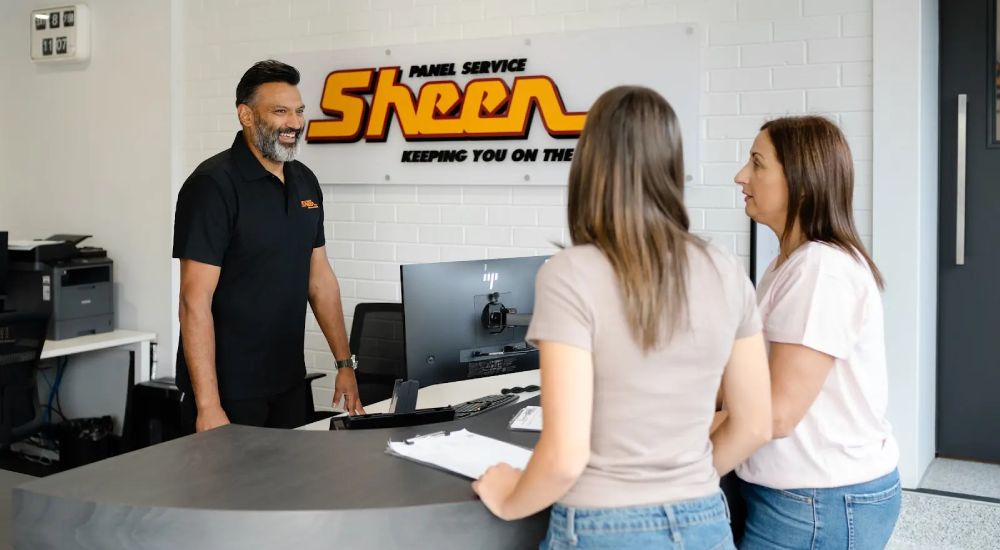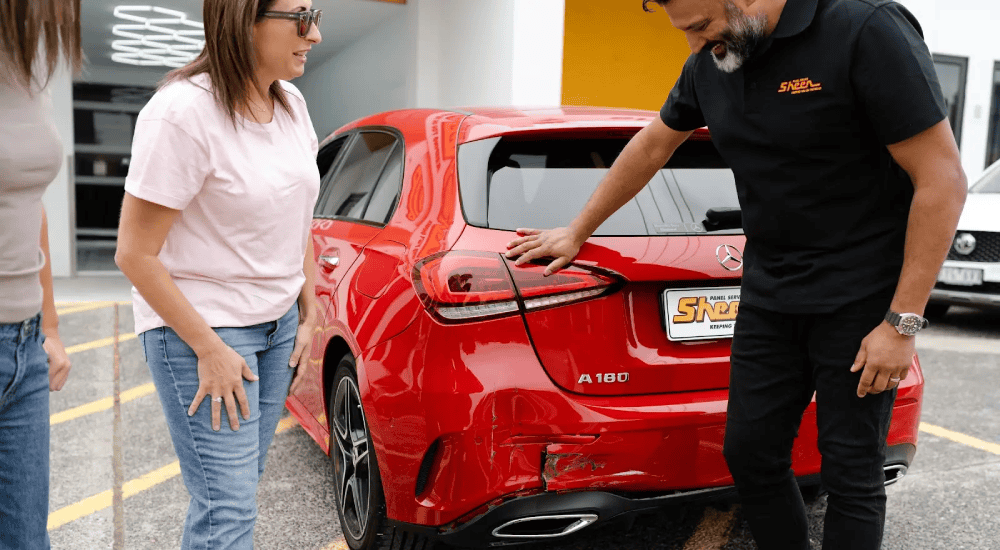Sheen Resources


If you’re in a car accident that wasn’t your fault, you might assume you won’t need to pay an insurance excess. Unfortunately, it’s not always that simple. Sometimes, your insurer may still ask you to pay an excess even if you weren’t at fault.
This article explains what a car insurance excess is, when insurers waive it, and the circumstances where you may still need to contribute. We’ll also share practical steps to avoid unnecessary costs and how Sheen can support you through the insurance claim and repair process.
What is a car insurance excess?
A car insurance excess is the amount you need to pay out of pocket when you make an insurance claim after a car accident. Your insurer covers the rest of the repair or replacement costs once you’ve paid the agreed excess amount.
Most car insurance policies include a basic excess, which applies to every claim, and sometimes an additional excess, which may apply depending on the circumstances of the incident. For example, you might have to pay an additional excess if a learner driver or young driver was involved in the accident.
The amount of excess you’ll need to pay is in your insurer’s Product Disclosure Statement (PDS) and Target Market Determination (TMD). These documents explain when an insurer may require you to pay more, waive the excess, or apply different fees.
Do I pay an excess if the car accident was not my fault?
In a not-at-fault car accident, you may not have to pay an insurance excess, but it depends on your insurer’s rules and the details of the incident. Many insurers will waive the car insurance excess if:
- You can prove the other driver was entirely at fault
- You can provide the at-fault driver’s name, address, and vehicle registration number
- Your insurer is confident they can recover the cost of repairs from the other party
If you can’t provide these details, your insurer may still ask you to pay the excess up front so repairs can begin. In some cases, this excess may later be refunded if fault is confirmed and costs are recovered.
Always check your car insurance policy and PDS to understand how your insurance works in the event of an accident. Sheen can also help you navigate the insurance claims while organising fast, high-quality smash repairs.
[sheen_usps][/sheen_usps]
When will I still need to pay an insurance excess?
Even if you’re in a non-fault accident, there are situations where your insurer may still require you to pay an excess. These depend on your policy and the circumstances of the incident. Common examples include:
- Partly at fault – If the insurer decides you contributed to the accident in any way.
- Dispute about fault – If it’s unclear who caused the car accident, you may have to pay the excess upfront so repairs can start. The excess may be refunded if it’s later proven you weren’t at fault.
- At-fault driver doesn’t have insurance – If the other driver is uninsured or refuses to pay, your insurer may ask you to pay the excess while they attempt recovery.
- Hit and run accidents – If the at-fault driver flees without leaving their contact details, insurers usually require you to pay the excess.
Each insurer has its own approach, which is outlined in your PDS. For consumer guidance, the Financial Rights Legal Centre explains when insurers can and cannot charge an excess.
How to avoid paying excess in a not-at-fault accident
It’s not always clear whether you should pay an excess after a car accident. Ultimately, your insurer decides based on your car insurance policy and the circumstances of the incident. Still, there are steps you can take to reduce the chance of being charged:
- Gather strong evidence – Take photos of the accident, record witness statements, and note the other driver’s details, including their vehicle registration number.
- Report the incident to police – If the at-fault driver flees the scene or refuses to provide information, file a police report. This supports your claim and may help avoid excess costs.
- Dispute the decision – If you believe you’ve been wrongly charged an excess, you can lodge a dispute with your insurer. If necessary, escalate to the Australian Financial Complaints Authority (AFCA).
- Seek legal support – Sometimes, Sheen works with partners like AANDI Lawyers to help recover costs from the at-fault driver or their insurer.
Always read the relevant PDS and insurance certificate issued by your insurer to understand your cover in detail. Sheen can also assist you directly with the claims process, ensuring that your repair and insurance claims are managed together. Our quotes and recommendations are always independent, with no obligation to proceed. We’ll even negotiate directly with your insurer on your behalf, so you’re not left handling complex claims alone.
What happens if the at-fault driver is uninsured?
Things can get complicated if the at-fault driver in your car accident doesn’t have car insurance. Typically, their insurance company would pay for the damage to your car and cover your costs. But without cover, the driver is personally responsible for repairs, medical bills, or other losses.
In practice, recovering money directly from an uninsured driver can be difficult. You may be asked to pay the excess upfront to your insurer while they try to recover costs. If the driver can’t pay, you might need legal support to settle the matter.
This is where understanding your policy type becomes critical:
- With comprehensive car insurance, your insurer will usually manage the repair and attempt recovery from the at-fault driver.
- With third party cover, you may have to pay more of the repair costs yourself.
Always check what you’re insured for and whether, depending on the circumstances of the incident, you might have to pay excess “at any time.” Comprehensive insurance may have a higher premium than a basic third-party policy, but it often saves you money in the long run by covering more repair costs.
As accredited members of the VACC and other industry associations, our workshops meet strict standards for quality and customer care, giving you confidence your vehicle is in expert hands. Sheen can help uninsured and insured drivers by arranging towing services and panel beating repairs, and supporting them through the claim process.
How Sheen helps with car insurance claims and repairs
When dealing with an insurance excess, it’s easy to feel unsure about your next steps, especially if you need to make a claim quickly after an incident. As one of Melbourne’s best-known repair networks, Sheen provides expert towing, panel beating, and support for major car brands such as Toyota, Mazda, and Hyundai. Sheen takes the stress out of the process, whether it’s a windscreen repair, hail damage, or a major car accident.
Our team can organise towing, manage your car insurance claim, and perform quality repairs to restore your vehicle. Even if the car is written off, we’ll guide you through the settlement process with your insurer. And if you’re uninsured, we’ll still help get you back on the road with a replacement vehicle.
At Sheen, we’ve seen every type of claim, from accidents where the fault and the other driver are obvious, to disputes about who was actually at fault. With over 50 years of experience since our founding in 1969, and multiple locations across Victoria, we have built a trusted legacy of helping Melbourne drivers through accidents and insurance claims. We even help in tricky situations like motorcycle crashes, vandalised vehicles, or storm damage. In the event of a claim, our priority is getting you back on the road as soon as possible.
So, if you’ve been in an accident that was not your fault, call Sheen first. We’ll cover your smash repairs, support your insurance claim, and keep you moving.
[upload_smash][/upload_smash]
FAQs about car insurance excess in not-at-fault accidents
Do I have to pay excess if a car accident wasn’t my fault?
Not always. If you can prove the other driver was at fault and provide their name, address, and vehicle registration number, your insurer may waive the car insurance excess. If those details are missing, you may still need to pay an excess upfront until fault is confirmed.
Who pays the excess in a car accident?
If you are at fault, you must pay the insurance excess before your insurer covers the rest of the claim. The at-fault driver or their insurer is generally responsible if you're not at fault. In hit-and-run or uninsured driver cases, your insurer may still ask you to pay an excess initially.
Can I avoid paying an excess in a non-fault accident?
Yes, in some cases. Gathering evidence like photos of the accident, witness statements, and the other driver’s insurance details increases the chance of having the car insurance excess waived. Always check your policy and PDS for the insurer’s rules.

.png)


















